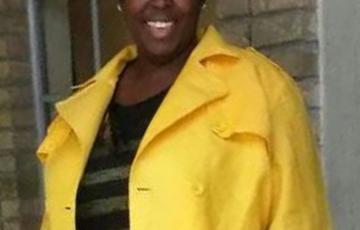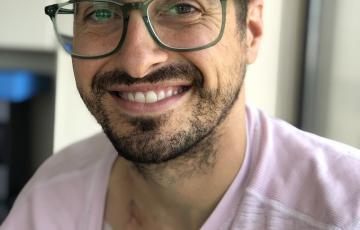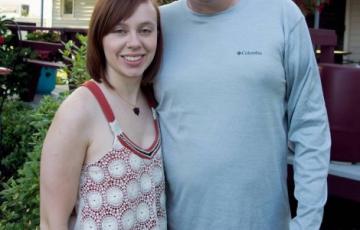Search Results

Dean
I was losing the battle with chronic lymphocytic leukemia (CLL) and lymphoma in August of 2013 when I ran across this quote from Albert Einstein, "There are only two ways to live your life. One is as though nothing is a miracle. The other is as though everything is a miracle." I decided to adopt this as my standard to live by. It gave me new insight and a passion for living that fueled my will to live.

Robyn
In October 2017, my wife Robyn Oshita passed away after a valiant two-and-a-half month battle against acute myeloid leukemia (AML). She was a loving wife, mother, and friend to everyone she met.

Alexis
CANCER, that one word that sits like a lump in the back of your throat making you unable to swallow...
I was in sixth grade when my hero, my dad, was diagnosed with hairy cell leukemia.
Over the years, my dad has gone through his fair share of chemotherapy. Usually after treatment, his cancer became dormant, and then resurfaced a few years later. The dreadful "process" would repeat itself, getting a little harder each time as his body became resistant to the therapy.

Robert
In 1990, I was diagnosed with M3 acute myeloid leukemia (AML) - now known as acute promyelocytic cancer (APL) - when I was a twenty-year-old college student studying abroad in Northern England.
I had ignored obvious symptoms for about a week leading up to my diagnosis, and it took another full week just to coordinate my departure from the UK to the University of Washington Medical Center in Seattle, not far from where I grew up. A host of complications followed during my first round of induction chemotherapy including massive amounts of internal bleeding.

Latasha
After a family vacation with her four kids and husband of 20 years, Latasha couldn't eat or hold her head up. After being in bed for almost a month, she thought she had the flu when her doctor broke the news that she had been diagnosed with acute myeloid leukemia (AML) and anemia.

Justin
My husband, Justin, was diagnosed with T-cell acute lymphoblastic leukemia (ALL) in June 2021. At the time, he was a healthy, energetic, 33-year-old dad of three. He just completed all treatment in January 2024. We received some funds from The Leukemia & Lymphoma Society (LLS) as well as information and inspiration. Throughout treatment, my husband fought so hard and had very difficult moments. He went into septic shock from a blood infection, had an ICU stay, and had to get both his hips replaced because of an infection that led to bone on bone. He couldn’t walk for months.

Kate
When I went for my annual physical in 2013, my doctor called me to tell me that my bloodwork looked strange. He asked me to get it tested again to be sure of the result. I did not have any symptoms at all. Within a week, I was diagnosed with chronic myeloid leukemia (CML), something I'd never heard of. I had no idea what this would mean. It took me a while to find the right oncology team, but once I did, they were amazing. After lots of tests (including a bone marrow biopsy), I was started on medication, at a low dose, because I'm a pretty small person.

Janet
I was diagnosed with acute myeloid leukemia (AML) at the age of 28, and our firstborn son was four months old. I am currently a 36-year survivor, married 41 years with four sons, four daughters-in-law, and eight grandchildren.

Gary
In 1999 I had a lump on my neck, and after strong urging from my wife and my mother, I finally went to my family doctor. My white blood cell counts were really high, and antibiotics didn't help. Eventually, a biopsy indicated chronic lymphocytic leukemia (CLL).

Babara
On October 3, 2019, I was diagnosed with chronic myeloid leukemia (CML) at the age of 58. I was asymptomatic, so I was in total denial that I had leukemia. I had just attended my 40th high school reunion, and I thought my health was great. After leaving the oncologist's office that day, I went home and discovered that I had blood in my urine, or was it post-menopausal bleeding? I was so confused and frustrated. I immediately made an appointment with my primary care physician to get a referral because I wasn't sure what kind of doctor I needed to see. Turns out, I also had cervical cancer.
Signs and Symptoms
It is common for children with AML to feel a loss of well-being because of the underproduction of normal bone marrow cells.
Symptoms of a low red blood cell count (called “anemia”) include the following:
- Fatigue
- Weakness
- Shortness of breath during normal physical activities
- Lightheadedness, dizziness or faintness
- Headaches
- Pale complexion
Symptoms of a low white blood cell count (called “neutropenia”) include the following:

Allyson
In November 2016 I was tired. TIRED. I had a 20-month-old and a 4-year-old, had just come off the busiest month of the year for work, and I figured I was tired for no other reason. But then tired became not having the energy to take care of my 20-month-old. Tired became going to be my best friend's wedding and needing to lay down in between steps. Shower, lay down. Makeup, lay down. Hair, lay down. Get dressed, sit for a minute. Walking a long hallway seemed daunting. And then carrying my son from my car at a gas station to the restroom inside on a road trip was too much.

Virginia
I have been living with chronic myelogenous leukemia (CML) since August 6, 1997. The way I see it, I’m alive today because of The Leukemia & Lymphoma Society (LLS). The pill I take each day that keeps my leukemia in remission exists today much because of research grants awarded to Brian Druker, M.D., PhD., of Oregon Health & Science University.
CLL Staging
Doctors use staging to help them predict chronic lymphocytic leukemia's (CLL's) progression and develop an appropriate treatment plan. Two staging systems, the Rai system and the Binet System, have been used throughout the world. In 2016, a new prognostic model called the CLL International Prognostic Index (CLL-IPI) was released, enabling a more targeted management of CLL.
Staging systems for CLL take into account:
Targeted Therapy
Targeted therapy is a type of treatment that uses drugs or other substances to identify and attack specific types of cancer cells with less harm to normal cells. Not all cancers have the same targets. Each type of targeted therapy works a little bit differently, but they all interfere with the growth and survival of cancer cells. To find the most effective treatment, your doctor may run tests to identify the genes, proteins and other factors in your cancer cells. This helps the doctor choose the most effective treatment for you based on the specific factors of your disease.
Stem Cell Transplantation
For some high-risk patients who are in remission, the doctor may recommend stem cell transplantation during the consolidation phase of chemotherapy.

Brianna
"He was the king of positivity" is what Dr. McCarthy at Roswell Park said to me the day after my Dad passed away from complications of GVHD or graft-versus-host disease. My Dad was a leader, someone who was always willing to help others, and always had a smile on his face. Not only was I his co-caregiver throughout his cancer journey, but he was also my caregiver during mine.

Reese
Before we knew the world of childhood leukemia, and long before bone marrow transplant was a part of our vocabulary, we had sweet little identical twin girls, named Reese and Quinn. The twins were born in Chicago on April 10, 2014. Reese and Quinn were healthy babies who grew into healthy toddlers and then their little sister Claire joined our world in 2016. These sisters are the best of friends and the greatest supporters of each other.

Samuel
On June 21, 2019, my sweet, goofy, little boy, Samuel, turned 3 years old, and we had a big celebration. We threw Samuel a beautiful birthday party surrounded by family and friends at a local farm. The kids played, fed the farm animals, went on pony and tractor rides, and ate pizza and cake. It was a day Samuel still remembers and talks about. He has always been so bright, even as a baby, saying words like “tickle” at 10 months old.

Lindsay
Hello, my name is Lindsay. I was recently diagnosed with chronic myeloid leukemia (CML).
Among being diagnosed with this my husband and I have been going through infertility as well. It is helpful to connect with others going through the same process that we are.
God bless!

Sahara
In August 2021, I was diagnosed with stage IV Hodgkin lymphoma (HL). I am now cancer-free. The Leukemia & Lymphoma Society (LLS) helped me tremendously throughout my process. I had the privilege of raising money for LLS through an Instagram campaign by sharing my story online.

Gina
In 1994, at the age of 29 I was diagnosed with stage IV acute myelogenous leukemia. I was told there was a five percent chance that I would survive. Having a husband and three kids, I was devastated!
I never thought this could happen to me, and it was a long hard fight, but I did it.
I survived and I feel proud to say I am a survivor!

Selina
My story starts when I was just eight months old. In March of 1994, it was discovered that I had a cheek tumor. Doctors removed the tumor, and I was treated with chemotherapy. I relapsed at two years old in 1995. I was diagnosed with acute myeloid leukemia (AML). Leukemic lesions had spread to my brain. I received intense chemotherapy and 14 days of cranial irradiation. I was very lucky that my little sister was born in June of 1995. Doctors had saved her umbilical cord (her stem cells). I underwent more chemotherapy and a stem cell transplant in October 1995.